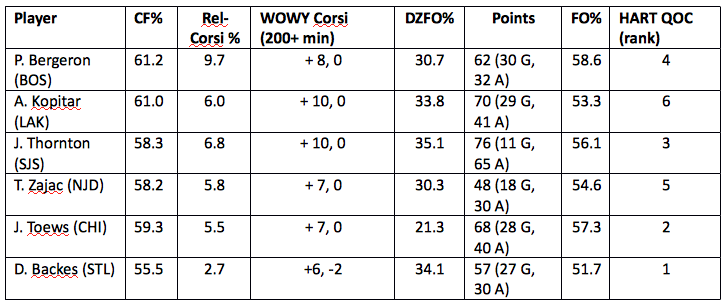Since the spring, I have been toying with the idea of using advanced stats to help decide the more ambiguous NHL player awards; the Selke for best defensive forward and the Norris, for best defenseman.
Corsi
I’ll describe the process by which I chose the candidates. There are obvious candidates (for now) and those are the ones who have won in the past and currently nominated. So players like Kopitar (LAK) and P. Bergeron (BOS) came to mind. Because a center has the most defensive responsibility, including taking the majority of face offs (a statistic to factor in), I focused on centers. Mind you, I noted some impressive stats for wingers along the way, but eventually decided that comparing centers and wingers is like comparing apples to oranges when it comes to defense. Perhaps there should be separate award for best defensive winger? A question for another day.
The first statistic I looked at was not their offensive production, or +/-, but their overall possession metric: Corsi differential (Corsi-For Percent; or CF %). Offensive production is also useful to include. I think it’s reasonable to assume that you would like even a defensive forward to be productive; balance and depth and all that. I did not factor in +/- because the sample size is too small in a single season. In fact, it takes about 3 seasons of data to arrive at a statistically significant +/-. That is to say, there is more randomness (“luck”) involved in goals for and against than non-statistical fan realizes. In short, +/- is statistically unreliable, and thus invalid, over a single season.
For those new to advanced hockey statistics, Corsi is the name given to shot attempts in 5-on-5 situations, which is composed of shots on net, blocked shots, and shots missing the net. Corsi, or shot attempts, is used as a broad metric to assess possession. The logic is if you shoot the puck at the net more than the opposing team, you tend to possess the puck more. Technically, then, it’s not really a measure of defense, but a measure of puck control. You can look at it this way, though: If you control the puck more, that’s less time the opponent has the puck. A good defense includes having a strong puck-controlling offense.
The CF% metric is calculated using the formula 100 x CF / (CF + CA), where CF = Corsi-For and CA = Corsi-Against. This metric gives a percentage that estimates whether the team has more or fewer shot attempts while the player in question is on the ice. Having a CF% of over 50% is an index of positive possession and under 50% indicates negative possession. To be clear, the number reflects all 5 players on the ice, not just the individual. As such, it’s a very broad and rough statistic, but it’s a starter. You have start somewhere, right?
By first looking at CF% among centers, I identified about 8-10 potential candidates. Each had a strong CF%, but what about teams who are strong in possession? (Here I am thinking about a team like New Jersey, who is a super-strong possession team and every player has a high CF%.) So how do we isolate individual performance from team performance?
Corsi: Relative & WOWY
We can take this a step further and examine the player’s With-or-Without-You (WOWY) Corsi. In a sense, this a breakdown of the Relative Corsi into its component player combinations. Perhaps there are few teammates who really help boost the player’s Corsi, whereas with most other teammates, being paired with the player drags down their Corsi. In this situation, the player in question is not driving possession, but is a passenger. He looks good because of other, stronger teammates carrying him (e.g., Kunitz reached career highs in his 30s because he plays with Crosby, not because he has somehow improved on his own). The detailed WOWY Corsi would be too much to include, but I can summarize by indicating the number of teammates the candidate helps (i.e., + X) and the number he hurts (i.e., - Y).
Measuring Defense with Corsi-Against?
Quality of Competition
I wish I could tell you how he came up with these numbers, but I was unable to decipher his method. Suffice to say, I will rank the players on this index in which 1 = the strongest opposition and 6 = the weakest. The index is called Hockey Analysis Rating Total (Offense & Defense) – Quality of Competition (HART QOC). That’s a mouthful and then some.
Zone Starts
Fancy Stat Best Defensive Forward Trophy Nominees
| | | |
Some Final Notes
Hope you enjoyed my first blog post here. Please vote!

 RSS Feed
RSS Feed
